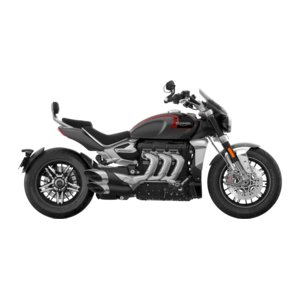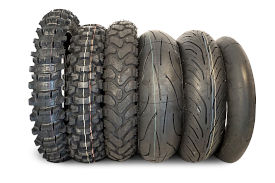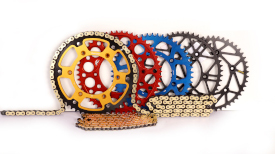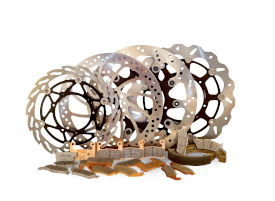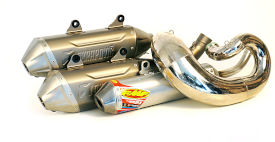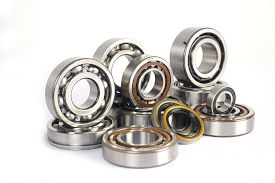Triumph Rocket 3 GT [2020-2022]: A Colossus Reimagined
Introduction
The Triumph Rocket 3 GT isn’t just a motorcycle—it’s a statement. A 2.5-liter inline-three engine, a 648-pound dry weight, and a silhouette that dominates any road it graces—this is a machine that defies conventional categorization. Built between 2020 and 2022, the Rocket 3 GT straddles the line between muscle cruiser and touring behemoth, offering a riding experience as unique as its specifications. Having spent time aboard this mechanical titan, I can confidently say it redefines what a "big bike" can be. Let’s dive into what makes this generation of the Rocket 3 GT unforgettable.
Design: Commanding Presence Meets Refined Detailing
The Rocket 3 GT’s design is a masterclass in balancing brute force with elegance. Its 98.4-inch (2,500 mm) length and 240mm-wide rear tire scream dominance, while the sculpted aluminum frame and single-sided swingarm add a touch of engineering artistry. The twin LED headlights, flanking Triumph’s signature triangular branding, give it a futuristic edge, and the hydroformed stainless-steel 3-into-1 exhaust system is a visual and auditory highlight.
The GT variant leans into touring comfort with a low 29.5-inch (750 mm) seat height, forward-set foot controls (adjustable in three positions), and a brushed aluminum pillion backrest. Color schemes like Phantom Black and Silver Ice/Storm Grey emphasize its premium appeal, while limited editions like the Triple Black and 221 Special Edition add exclusivity with matte finishes and red accents.
Despite its size, the Rocket 3 GT hides clever details: foldaway pillion footpegs, a Monza-style fuel cap, and a hidden USB port under the seat. It’s a bike that rewards closer inspection—every component feels purpose-built and meticulously finished.
Engine: The Heart of a Titan
The numbers alone are staggering: 2,458cc, 165 HP @ 6,000 RPM, and 221 Nm (163 lb-ft) of torque at 4,000 RPM. This is the largest production motorcycle engine in the world, and it delivers power with the subtlety of a sledgehammer.
Twist the throttle, and the Rocket 3 GT surges forward with a deep, guttural growl from its Arrow-branded exhaust. The torque curve is virtually flat, meaning acceleration feels relentless whether you’re in second gear or sixth. Cruising at 70 mph (113 km/h) in top gear, the engine hums at a relaxed 3,000 RPM, yet a flick of the wrist unleashes enough force to shame most sports cars.
The ride-by-wire throttle and torque-assist hydraulic clutch keep the experience manageable, but this is still a bike that demands respect. Fuel consumption averages 34.5 MPG (6.82 L/100 km)—remarkably efficient for its size, though you’ll be too busy grinning to care about fuel stops.
Handling: Defying Physics
At 648 lbs (294 kg), the Rocket 3 GT shouldn’t handle this well. Yet Triumph’s aluminum frame and Showa suspension—47mm USD forks up front and a fully adjustable monoshock at the rear—work miracles. The bike feels planted in corners, with the Avon Cobra Chrome tires (150/80-R17 front, 240/50-R16 rear) offering surprising grip.
The steering is lighter than expected, thanks to a 27.9° rake and 5.3-inch (135 mm) trail. Low-speed maneuvers are manageable once you acclimate to its size, and the shaft drive eliminates chain maintenance hassles. Braking is equally impressive: dual 320mm Brembo Stylema discs up front and a 300mm rear disc, all backed by cornering ABS. It stops with authority, though you’ll need a firm squeeze on the lever.
Technology: Modern Muscle
Triumph’s second-gen TFT dashboard is a standout here. The 5-inch display is crisp, customizable, and angle-adjustable. Four riding modes (Rain, Road, Sport, Rider) tweak throttle response and traction control, while features like hill-hold, cruise control, and heated grips (standard on the GT) enhance practicality.
The optional My Triumph connectivity system adds GoPro control, turn-by-turn navigation, and music integration—though the Bluetooth module is an accessory. Cornering ABS and traction control, governed by an IMU, inspire confidence in wet or twisty conditions. It’s a tech suite that rivals modern ADV bikes, proving the Rocket 3 GT isn’t stuck in the past.
Competition: Giants of the Road
The Rocket 3 GT exists in a niche of its own, but rivals include:
- Harley-Davidson Fat Boy 114: A classic cruiser with a 1,868cc V-twin. Less power (93 HP) and tech, but unmatched heritage.
- Ducati Diavel 1260: A sportier alternative with a 1,262cc V-twin (162 HP). Lighter and sharper, but lacks the Rocket’s touring comfort.
- Indian Chief Dark Horse: A 1,890cc V-twin cruiser with retro styling. More affordable but down 60 lb-ft of torque.
The Rocket 3 GT outmuscles them all, offering a blend of raw power, modern tech, and long-distance capability that’s unparalleled in its class.
Maintenance: Keeping the Beast Alive
Ownership is surprisingly straightforward for such a complex machine:
- Oil Changes: 4.6 liters of 15W-50 API SH oil every 10,000 miles (16,000 km).
- Coolant: 2.6 liters of ethylene glycol mix, checked annually.
- Shaft Drive: Minimal maintenance compared to chain-driven bikes—just 75W-90 Hypoid oil changes every 20,000 miles.
- Tires: The massive 240mm rear tire wears evenly if you avoid aggressive launches. Check pressures regularly (2.9 bar/42 psi front and rear).
Upgrades to consider from MOTOPARTS.store:
- High-flow air filters for improved throttle response.
- Aftermarket exhaust systems to amplify that triple-cylinder roar.
- Adjustable levers for riders with smaller hands.
Conclusion
The Triumph Rocket 3 GT is a paradox—a bike that shouldn’t work but absolutely does. It’s brutish yet refined, colossal yet agile, and packed with tech that belies its retro-cruiser looks. For riders who crave exclusivity and earth-moving torque, nothing else comes close.
Whether you’re carving canyon roads or devouring highways, the Rocket 3 GT does it with a swagger that’s impossible to ignore. And when it’s time to personalize or maintain your beast, MOTOPARTS.store has the expertise and parts to keep it dominating the road.
Ride hard, ride bold, and let the Rocket 3 GT remind the world what real power looks like.
Specifications sheet
| Engine | |
|---|---|
| Stroke: | Four-stroke |
| Max power: | 123 kW | 165.0 hp |
| Max torque: | 221 Nm |
| Fuel system: | Ride-by-Wire fuel injection |
| Max power @: | 6000 rpm |
| Displacement: | 2458 ccm |
| Fuel control: | Double Overhead Cams (DOHC) |
| Max torque @: | 4000 rpm |
| Bore x stroke: | 110.2 x 85.9 mm (4.3 x 3.4 in) |
| Configuration: | Inline |
| Cooling system: | Liquid |
| Compression ratio: | 10.8:1 |
| Number of cylinders: | 3 |
| Dimensions | |
|---|---|
| Wheelbase: | 1677 mm (66.0 in) |
| Dry weight: | 294 |
| Seat height: | 750 mm (29.5 in) |
| Overall width: | 886 mm (34.9 in) |
| Overall height: | 1066 mm (42.0 in) |
| Overall length: | 2500 mm (98.4 in) |
| Fuel tank capacity: | 18 L (4.76 US gal) |
| Drivetrain | |
|---|---|
| Final drive: | shaft |
| Transmission: | 6-speed |
| Maintenance | |
|---|---|
| Engine oil: | 15W-50 |
| Brake fluid: | DOT 4 |
| Spark plugs: | NGK LMAR8A-9 |
| Spark plug gap: | 0.8–1.0 mm |
| Final drive oil: | 75W-90 GL-5 Hypoid |
| Coolant capacity: | 2.6 |
| Engine oil capacity: | 4.6 |
| Engine oil change interval: | Every 16,000 km or 12 months |
| Valve clearance check interval: | 24,000 km / 15,000 mi |
| Recommended tire pressure (rear): | 2.9 bar (42 psi) |
| Recommended tire pressure (front): | 2.9 bar (42 psi) |
| Additional Features | |
|---|---|
| Lighting: | All-LED with Daytime Running Lights (DRL) |
| Technology: | Cornering ABS, Traction Control, Hill-Hold Control, Cruise Control, Keyless ignition |
| Instruments: | TFT multi-functional dashboard |
| Rider modes: | Rain/Road/Sport/Rider-configurable |
| Chassis and Suspension | |
|---|---|
| Rake: | 27.9° |
| Frame: | Aluminum |
| Trail: | 135 mm (5.3 in) |
| Rear tire: | 240/50 -16 |
| Front tire: | 150/80 -17 |
| Rear brakes: | Single 300 mm disc, Brembo M4.32 4-piston caliper (Cornering ABS) |
| Front brakes: | 2 x 320 mm discs, Brembo M4.30 Stylema® 4-piston radial calipers (Cornering ABS) |
| Rear suspension: | Fully adjustable Showa monoshock with remote hydraulic preload |
| Front suspension: | Showa 47mm USD forks, compression and rebound adjustable |
| Rear wheel travel: | 107 mm (4.2 in) |
| Front wheel travel: | 120 mm (4.7 in) |



